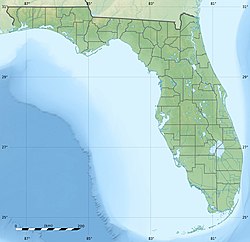
Back ملعب ميامي أورانج بول Arabic Miami Orange Bowl AST Orange Bowl CEB Orange Bowl Stadium German Miami Orange Bowl Spanish Miami Orange Bowl French Օրենջ բոուլ մարզադաշտ Armenian Miami Orange Bowl Italian マイアミ・オレンジボウル Japanese 마이애미 오렌지 볼 Korean
The Sea Football Heaven The Dock The Old Horseshoe in Little Havana | |
 Aerial view of the stadium, c. 1976 | |
Location in the United States Location in Florida | |
| Former names | Burdine Stadium (1937–1959) |
|---|---|
| Address | 1501 Northwest 3rd Street Miami, Florida United States |
| Coordinates | 25°46′41″N 80°13′12″W / 25.778°N 80.220°W |
| Owner | City of Miami |
| Operator | City of Miami |
| Type | Stadium |
| Capacity | 72,319 (2003–2007)[1]
Former capacity: List
|
| Surface | Natural grass (1976–2008) PolyTurf (1970–1975) Natural grass (1937–1969) |
| Current use | Football |
| Construction | |
| Broke ground | 1936 |
| Opened | December 10, 1937 |
| Expanded | 1944, 1947, 1950, 1953, 1955, 1968 |
| Closed | January 26, 2008 |
| Demolished | March 3–May 14, 2008 |
| Construction cost | $340,000 ($7.21 million in 2023 [5]) |
| Tenants | |
| Miami Hurricanes (NCAA) (1937–2007) Orange Bowl (NCAA) (1938–1996, 1999) Miami Seahawks (AAFC) (1946) Miami Dolphins (AFL / NFL) (1966–1986) Miami Toros (NASL) (1973–1975) Miami Freedom (ASL / APSL) (1988–1992) Miami Tropics (SFL) (2000) FIU Panthers (NCAA) (2007) Miami FC (USL First Division) (2007) | |
The Miami Orange Bowl was an outdoor athletic stadium in Miami, Florida, from 1937 until 2008. The stadium was located in the Little Havana neighborhood west of downtown Miami. The venue was considered a landmark and served as the home stadium for the Miami Hurricanes college football team from 1937 through 2007 and for the Miami Dolphins for the Dolphins' first 21 seasons, until Joe Robbie Stadium (now Hard Rock Stadium) opened in nearby Miami Gardens in 1987. The stadium also was the temporary home for the FIU Golden Panthers for one year, in 2007, while its on-campus FIU Stadium underwent expansion.
Opened in 1937, it was originally known as Burdine Stadium. In 1949, it was renamed the Orange Bowl for the Orange Bowl college football bowl game, which was played annually at the venue following every season from 1938 to 1996. The event was moved to Pro Player Stadium (now Hard Rock Stadium) beginning on December 31, 1996. In January 1999, it returned to the Orange Bowl a final time due to a scheduling conflict. From 1956 to 1960, the Minor League Baseball Miami Marlins team occasionally played games in the Orange Bowl.
The stadium was located on a large city block bound by Northwest 3rd Street to its south, Northwest 16th Avenue to its west, Northwest 6th Street to its north, and Northwest 14th Avenue to its east, which was an open end of the stadium.
The Orange Bowl was demolished in 2008. LoanDepot Park, the home ballpark of the Miami Marlins of Major League Baseball, was built on the site. Construction began in July 2009, and the new stadium opened on March 5, 2012.
- ^ a b c d e f g h i j k l "Orange Bowl". Football.ballparks.com. Archived from the original on March 28, 2012. Retrieved October 17, 2011.
- ^ https://news.google.com/newspapers?id=USwyAAAAIBAJ&sjid=T-oFAAAAIBAJ&pg=3808,443393&dq=orange+bowl+72880&hl=en[permanent dead link]
- ^ https://news.google.com/newspapers?id=rHwzAAAAIBAJ&sjid=AesFAAAAIBAJ&pg=2621,3274453&dq=orange+bowl+70097&hl=en[permanent dead link]
- ^ Golenpaul, Ann (February 28, 2007). Information please almanac, atlas ... – Dan Golenpaul Associates – Google Books. Retrieved October 17, 2011.
- ^ 1634–1699: McCusker, J. J. (1997). How Much Is That in Real Money? A Historical Price Index for Use as a Deflator of Money Values in the Economy of the United States: Addenda et Corrigenda (PDF). American Antiquarian Society. 1700–1799: McCusker, J. J. (1992). How Much Is That in Real Money? A Historical Price Index for Use as a Deflator of Money Values in the Economy of the United States (PDF). American Antiquarian Society. 1800–present: Federal Reserve Bank of Minneapolis. "Consumer Price Index (estimate) 1800–". Retrieved February 29, 2024.

